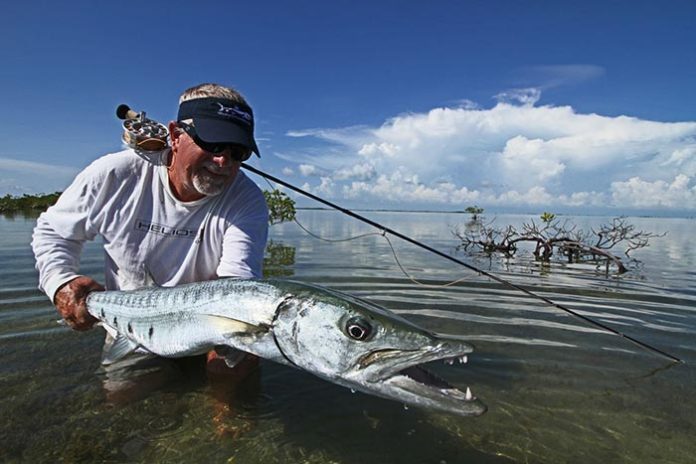Photo by Greg Vincent, of H2O Bonefishing
These fearsome-looking saltwater predators are also fantastic game fish that will often take an angler deep into his backing and leap many times during the fight.
The great barracuda (Sphyraena barracuda) isn’t generally considered one of the premier saltwater fly rod species—it’s not part of the flats Grand Slam, for instance—and few fly fishers head to the tropics specifically chase this toothy beast. But when you spot one a silvery torpedo lying in ambush in a deep slot or tucked into the mangroves, it’s time to pick up a rod rigged with a wire leader and a baitfish pattern. Great barracuda can be maddeningly sullen and wary—not even reacting to your offering or just swimming slowly away—but at other times they will attack a fly with reckless abandon and at great speed. And that’s when the fun really starts because barracuda fight like they mean it.
Range and Species History
Depending on your source, there are between 20 and 28 species of barracuda worldwide, and the great barracuda is the most common. Sphyraena barracuda is found virtually around the globe in near-shore tropical and subtropical seas, especially where there are reefs and sea grasses. In the Western Hemisphere, the species ranges from Massachusetts to Brazil, including the Gulf of Mexico and Caribbean Sea, and it is also widespread in the Eastern Atlantic, Indian Ocean, and throughout Micronesia. However, the great barracuda is rare or nonexistent along the West Coast and in the far-eastern Pacific, although other barracuda species do swim in those waters.
Great barracuda sometimes inhabit open ocean and water up to 100 feet deep, but they are most often found around structure—reefs, mangroves, shipwrecks and the like—in shallow water, less than 50 feet deep. Not much is known about the species’ spawning habits, but mating most likely occurs offshore. Juvenile fish hide in estuaries, mangroves, and sea grasses, which offers protection from predators and abundant prey. After two years, the young fish head for deeper water. They can live up to 14 years and grow to remarkable proportions; the largest specimens more than 6 feet long and over 100 pounds.
Great barracuda are solitary fish, but they will school up to chase prey into a bait ball. When they are alone, they rely on surprise, speed, and their impressive teeth to capture prey. The barracuda lies in wait, barely even moving its fins, until an unsuspecting baitfish swims into the predator’s attack window. Although they are not particularly maneuverable and attack in a straight line, great barracuda are capable of short bursts up to 35 miles per hour. Two rows of teeth—a row of smaller, razor-sharp cutting teeth on the outside and a row of dagger-like piercing teeth inside—mean the prey has little chance once in the barracuda’s jaws. Smaller fish are swallowed whole, while larger fish are cut into pieces and then devoured.

Photo by Sandy Hays
Dangers to Humans
Because of the barracuda’s impressive dentition and vaguely shark-like profile, many people believe that the species is dangerous to humans, and stories of barracuda attacking swimmers or divers are quite common. One often hears that that the fish will attack if a swimmer or diver is wearing flashy jewelry, which supposedly imitates a baitfish. The fact is that there have been only about twenty-five documented attacks by barracuda in the past century, and the majority of these involve divers who are spearfishing or people who intentionally invade the fish’s personal space. Oftentimes, a barracuda tries to steal a spearfisher’s fish, and a battle ensues, during which the human receives some lacerations. Anglers, snorkelers, and swimmers really have nothing to fear. Watch your fingers while removing a fly, though.
Eat at Your Own Risk
Although your chances of being attacked by a barracuda are practically nil, the species does cause harm to thousands of humans around the world per year—by poisoning them. The barracuda is at the top of the CDC’s list of predatory fish that should not be consumed because of the risk of ciguatera, a food-borne illness caused by eating reef fish. Ciguatoxins are created by algaes, which are then consumed by small fish, which are, in turn, eaten by larger fish. Since barracuda are the apex predators on the reef, and the toxins become concentrated in their flesh and viscera through a process called biomagnification. Although ciguatera is rarely fatal, it can cause gastrointestinal and neurological problems. The symptoms can last for weeks or even years. If you do plan to eat a barracuda, smaller fish are less dangerous, and stick to eating just the meat.
Tactics and Flies
The IGFA all-tackle record barracuda was caught at Christmas Island in 2012 and weighed in at 87 pounds, 3 ounces, but most fish targeted by fly fishers on the flats are considerable smaller. Rods from 9-weight through 12-weight will give you enough leverage to battle big fish, and of course you’ll need a wire leader. The key to a good retrieve is speed: the faster, the better.
Barracuda feed almost exclusively on other fish, so long, slim baitfish patterns are your best choices. Because of their strong jaws and teeth, the fish will bend light hooks and shred poorly constructed flies. So make sure that your hooks are strong, the points are razor sharp, and use patterns that incorporate a stinger hook whenever possible. You don’t need to worry about matching the hatch, but carry a variety of colors, such as chartreuse, black, red-over-white, and pearl.
Credit: Source link






























